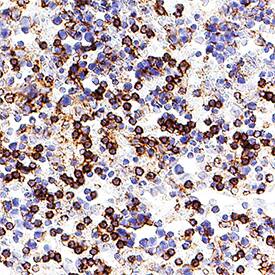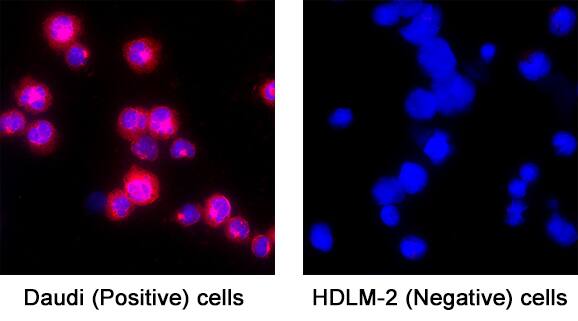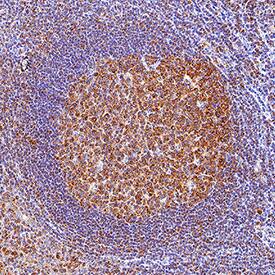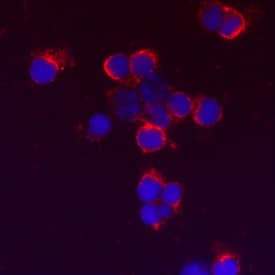Human/Mouse TLR9 Antibody
R&D Systems, part of Bio-Techne | Catalog # MAB36581

Key Product Details
Species Reactivity
Applications
Label
Antibody Source
Product Specifications
Immunogen
Accession # Q9NR96
Specificity
Clonality
Host
Isotype
Scientific Data Images for Human/Mouse TLR9 Antibody
TLR9 in Mouse Splenocytes.
TLR9 was detected in immersion fixed mouse splenocytes using Mouse Anti-Human TLR9 Monoclonal Antibody (Catalog # MAB36581) at 3 µg/mL for 3 hours at room temperature. Cells were stained using the NorthernLights™ 557-conjugated Anti-Mouse IgG Secondary Antibody (red; NL007) and counterstained with DAPI (blue). Specific staining was localized to plasma membrane. View our protocol for Fluorescent ICC Staining of Non-adherent Cells.TLR9 in Mouse Spleen.
TLR9 was detected in perfusion fixed frozen sections of mouse spleen using Mouse Anti-Human TLR9 Monoclonal Antibody (Catalog # MAB36581) at 1.7 µg/mL for 1 hour at room temperature followed by incubation with the Anti-Mouse IgG VisUCyte™ HRP Polymer Antibody (VC001). Tissue was stained using DAB (brown) and counterstained with hematoxylin (blue). Specific staining was localized to plasma membrane. View our protocol for IHC Staining with VisUCyte HRP Polymer Detection Reagents.Detection of TLR9 in Daudi Human Burkitt's Lymphoma Cell Line (positive) and HDLM-2 Human Hodgkin’s Lymphoma Cell Line (negative).
TLR9 was detected in immersion fixed Daudi Human Burkitt's Lymphoma Cell Line (positive) and absent in HDLM-2 Human Hodgkin’s Lymphoma Cell Line (negative) Cells using Mouse Anti-Human/Mouse TLR9 Monoclonal Antibody (Catalog # MAB36581) at 5 µg/mL for 3 hours at room temperature. Cells were stained using the NorthernLights™ 557-conjugated Anti-Mouse IgG Secondary Antibody (red; Catalog # NL007) and counterstained with DAPI (blue). Specific staining was localized to cytoplasm. View our protocol for Fluorescent ICC Staining of Non-adherent Cells.Applications for Human/Mouse TLR9 Antibody
Immunocytochemistry
Sample: Immersion fixed mouse splenocytes, Daudi Human Burkitt's Lymphoma Cell Line (positive) and HDLM-2 Human Hodgkin's Lymphoma Cell Line (negative) Cells.
Immunohistochemistry
Sample: Perfusion fixed frozen sections of mouse spleen and immersion fixed paraffin-embedded sections of human tonsil
Reviewed Applications
Read 1 review rated 5 using MAB36581 in the following applications:
Formulation, Preparation, and Storage
Purification
Reconstitution
Formulation
*Small pack size (-SP) is supplied either lyophilized or as a 0.2 µm filtered solution in PBS.
Shipping
Stability & Storage
- 12 months from date of receipt, -20 to -70 °C as supplied.
- 1 month, 2 to 8 °C under sterile conditions after reconstitution.
- 6 months, -20 to -70 °C under sterile conditions after reconstitution.
Background: TLR9
TLR9 (Toll receptor 9; also CD289) is a 145-150 kDa member of the Toll-like receptor family of molecules. It is expressed by colonic epithelium, CD123+ plasmacytoid dendritic cells, and transitional B cells, and responds to unmethylated DNA CpG motifs that contain either a GTCGTT sequence (in human), or a GACGTT sequence (in mouse). TLR9 is found in the ER and translocates to either the cell membrane or to lysosomes where it binds bacterial DNA. Precursor human TLR9 is a type I transmembrane protein 1032 amino acids (aa) in length. It possesses a 793 aa extracellular region that contains 26 LRRs (aa 26-818) plus a 193 aa cytoplasmic domain. The full-length 150 kDa form is suggested to be ligand-binding but nonsignaling. The active form is believed to be an 80 kDa cleavage product found in the endosome compartment. There are multiple splice forms. One contains a deletion of aa 2-16, a second possesses an alternate start site at Met58, while a third and fourth show alternative start sites aa 23 and 24 upstream of the standard site. Over aa 64-189, human TLR9 shares 76% aa identity with mouse TLR9.
Long Name
Alternate Names
Gene Symbol
UniProt
Additional TLR9 Products
Product Documents for Human/Mouse TLR9 Antibody
Product Specific Notices for Human/Mouse TLR9 Antibody
For research use only



